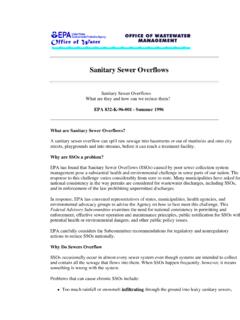Transcription of Sizing Up a Sump Pump - University of Illinois Urbana ...
1 1 Sizing Up a sump PumpWater WorldIt s every homeowner s nightmare abasement under water. Carpeting the ongoing battle for dry basements, sump pumps play a pivotal role. A pump typicallyhas to be replaced every few years. But if yousize it correctly, you can extend the life of yourpump. What s more, you can ensure that youhave the right pump for the you re selecting the size of a sumppump, you need two pieces of information: System capacity Total Dynamic Head (Static Head plusFriction Head)Determine System CapacityIt s important that your pump can draw waterout of the basin (or sump pit ) faster than waterflows into it. Therefore, the first thing you needto measure is the amount of water that drainsinto the basin during a high-flow a heavy rain, stick a ruler in the basinand measure how many inches of water flowinto the basin in 60 seconds.
2 This will tell youhow many gallons flow into the basin perminute, which is the System you have an 18-inch-diameter basin, 1inch of water is equal to 1 gallon. If you have a24-inch-diameter basin, 1 inch of water isroughly equal to 2 you find out that more than 30 gallons ofrainwater flow into the basin per minute, you rebetter off with a 24-inch-diameter basin. Also,the water level should never be allowed to gohigher than the bottom of the inlet pipe of thefoundation drain what if you re building a new home anddon t have a system installed yet? In that case,there are some general you re building on sandy soil, plan for asystem capacity of 14 gallons per minute forevery 1,000 square feet of you re building on clay soil, plan for asystem capacity of 8 gallons per minute forevery 1,000 square feet of : Using a ruler, you find that 18inches of water flow into your sump pump basinin 60 seconds.
3 Because you have the smallerdiameter basin, each inch equals 1 , your System capacity is 18 gallonsper Static HeadTotal Dynamic Head is equal to Static Head(or vertical lift ) plus Friction Head is the vertical height that thewater rises through the discharge pipe. Beginmeasuring from the point where water entersthe sump pump. Then measure up verticallyto where the pipe becomes horizontal (seeFigure 1).Example: Assume that the height from thesump pump to the point where the dischargepipe becomes horizontal is 13 feet. This is theStatic Friction HeadDetermining Friction Head is more involvedthan finding out the Static Head. Friction Head is the equivalent length of pipe plus the actuallength of pipe multiplied by the friction loss divided by follows are four steps in figuring outFriction 1.
4 Determine Equivalent Lengthof PipeThe equivalent length of pipe is determinedby how many pipe fittings are required for yoursystem. Table 1 shows the equivalent length ofpipe for various fittings, based on pipe : Assume you re using 1 -inchpipe, with three 90-degree elbows and 1 checkvalve. According to Table 1, three elbows feet of equivalent pipe, while the checkvalve adds feet. The total equivalent feetStep 2. Determine the Actual Pipe LengthThe actual pipe length is the length of piperunning horizontally out of the house. You shouldbe able to see where the pipe dischargesoutside of the : In our example, the length ofdischarge pipe is 100 3. Determine Friction LossFriction loss is how much friction slows theflow of water moving through the pipe.
5 Table 2shows what friction loss occurs for differentpipe sizes, depending on how many gallons ofwater per minute move through the Table 2, use your System Capacitynumber as the gallons per minute. Example: If 18 gallons per minute flowthrough your 1 -inch pipe, it would create afriction loss of per 100 feet of 1. A sump Pump SystemThe sump Pumpof pipe is 22 4. Put it All TogetherTo figure out Friction Head, add the actuallength of the discharge pipe to the equivalentlength of pipe from fittings. Then multiply by thefriction loss and divide by : Add the actual length of thedischarge pipe (100 feet) with the equivalentlength of pipe from fittings (22 feet) to get 122feet. Then multiply this by the friction loss per100 feet of pipe ( ) and divide by x 100 = is the Friction HeadDetermining Total Dynamic HeadNow that we ve determined Static Head andFriction Head, we simply add the numbers toget Total Dynamic : Add the Static Head (13 feet) tothe Friction Head ( ) to get a Total DynamicHead of Round up to 20 the PumpYou now know your System capacity (18gallons per minute) and you know the TotalDynamic Head (20 feet).
6 So you re ready toselect a sump pumps have charts or curvesthat show how many gallons per minute theycan pump for different lengths of head (SeeFigure 2). You ve already determined howmany gallons per minute must be pumped look at these charts and make sure that thepump can handle that many gallons don t want a pump that is either toosmall or too powerful. If the pump is too small,it won t be able to keep up with water flowingTable 1. Equivalent Length of PipeDue to FittingsTable 2. Friction Loss Per 100 Feet ofPlastic Schedule 40 PipeFigure 2. Sample sump Pump Performance Curves4 August 2005 Number 8 SourcesDuane Friend, University of Illinois Extension natural resources educatorTed Funk, U of I agricultural and biological engineerWritersDuane Friend, U of I Extension natural resources educatorDoug Peterson, U of I Extension communications specialistIllustratorMic GreenburgLand & Water CoordinatorMichael C.
7 Hirschi, U of I Extension soil and water specialistinto the basin. If the pump is too powerful, it will short cycle. This means the pump will startand stop frequently, which can cause prematurepump : If the Total Dynamic Head is 20feet, you have only one choice among the fourpumps shown in Figure 2. Only Pump 1 will beable to handle 18 gallons per minute. The otherthree pumps can t handle any more than 12gallons per that changing to a larger size of pipe inthis case might lower the friction head enoughto enable you to use a different pump (Pump 2on the chart).Maintaining the PumpPeriodically maintain your pump by doing thefollowing: Check the operation of the float to makesure that its up-and-down movement is notrestricted. Check the outside pipe when the pump isrunning to make sure it is discharging things can cause water not to bedischarged, including a stuck check valve,the impeller loose on its shaft, or a pluggedwater pipe.
8 If the pump has not had to run for severalmonths, put enough water in the sumppump basin to trigger the float switch. Thatway, you ensure that the pump is still operat-ing properly. Other ConsiderationsBasin Size. Most residences have an 18-inch diameter basin or sump pit. Basin sizeplays a part in how long the pump runs and howlong it takes to fill up. If your existing basin isundersized and fills too quickly between pump-ing cycles, it may be worth installing a widerbasin to accommodate the cheaper option may be installing anadjustable float switch that allows the water torise to a higher level before turning the pumpon. Most pumps depend on having water in thepump at all times to lubricate and cool pumpseals. So make sure the float switch is posi-tioned to prevent the pump from running pumps have floats that can beadjusted to different lengths for valve.
9 Select a swing-type checkvalve of the same size as the discharge it just above the sump pump. The checkvalve keeps the water in the discharge pipefrom flowing back into the basin between Circuit. The sump pump mustbe supplied with its own dedicated motorcontrol circuit and breaker. Be sure to observeall applicable local electrical codes and ordi-nances when installing electrical circuits.




![1[SCHEDULE VI]](/cache/preview/d/6/4/6/4/2/4/9/thumb-d6464249d79972a2e804a0aa4573c697.jpg)

